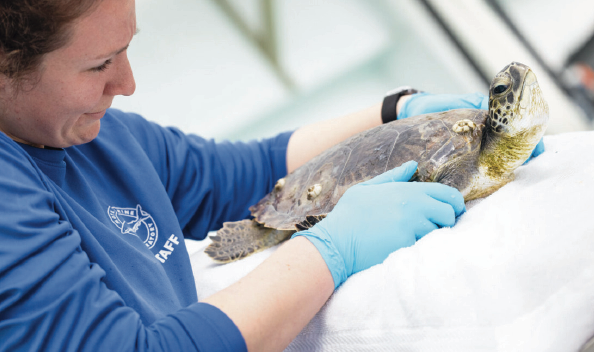As Atlantic temperatures drop into the 50s, hundreds of green sea turtles are being rescued from the frigid waters off Florida’s East Coast. Last week alone, Mote Marine Laboratory & Aquarium’s Sea Turtle Rehabilitation Hospital received 22 cold-stunned juvenile green turtles.
Cold-stunning occurs when turtles become lethargic due to rapidly dropping water temperatures. As ectothermic, or “cold-blooded,” animals, sea turtles cannot regulate their body temperature internally and rely on their environment to stay warm. When water temperatures drop too quickly, turtles can go into a hypothermic-like state where their body functions slow dramatically. Cold-stunned turtles often appear lifeless, floating at the water’s surface or onshore, leaving them vulnerable to predators, boat strikes, and exposure-related complications such as pneumonia, infection, and frostbite.
During this cold-stunning event, the affected turtles were initially brought to The Sea Turtle Hospital at the University of Florida Whitney Laboratory in St. Augustine, Florida, for triage. As part of a coordinated rescue effort, the Florida Fish and Wildlife Conservation Commission (FWC), New England Aquarium, and multiple rehabilitation facilities across the state work together to ensure turtles receive the care they need. Once stabilized, the turtles are distributed among rehabilitation centers, including Mote Marine Laboratory, for further treatment.
Upon arrival at Mote’s Sea Turtle Rehabilitation Hospital, the turtles undergo thorough health assessments. Mote’s expert Sea Turtle Rehabilitation team then develops individualized treatment plans based on each turtle’s condition. Over the next several days, the turtles are slowly warmed, with their tank water temperature increasing by approximately 3–4 degrees per day until it reaches the optimal range of 79-80 degrees. They are closely monitored to ensure they can lift their heads above the water to breathe properly (clearing) and regain full use of their flippers. If a turtle cannot breathe on its own, it is dry-docked while it regains strength.
During their stay, the turtles receive a complex diet consisting of capelin, squid, shrimp, lettuce, and seagrass. As they recover, they are gradually introduced to Environmental Enrichment Devices (EEDs), which help them reacclimate to the marine environment prior to release. Supportive care—including fluid therapy, antibiotics if needed, and careful observation—typically results in a successful recovery, allowing the turtles to return to the wild.
The last major cold-stunning event that impacted the entire state of Florida was in 2010, when over 5000 sea turtles were stranded. In past years, Mote has primarily rehabilitated cold-stunned Kemp’s ridley turtles transported from New England. Once fully recovered, these juvenile green turtles will be released back along Florida’s East Coast.
Each group of cold-stunned turtles is given themed names to help staff track and remember them in the years to come. This year, the theme is birds, with names such as Owl, Raven, Bluejay, Finch, and Crow. To follow their rehabilitation progress, visit mote.org/hospital.
Mote’s Sea Turtle Rehabilitation Hospital had been closed for four months following the back-to-back hurricanes in late 2024. Severe water and wind damage forced extensive rebuilding efforts, including tearing out walls, replacing pumps, and installing new appliances like refrigerators and washing machines. The hospital was scheduled to reopen the following Monday, but when FWC called for assistance, Mote’s team quickly mobilized to provide emergency care.
Mote Receives 22 Green Turtles in Wake of Recent Cold Snap

